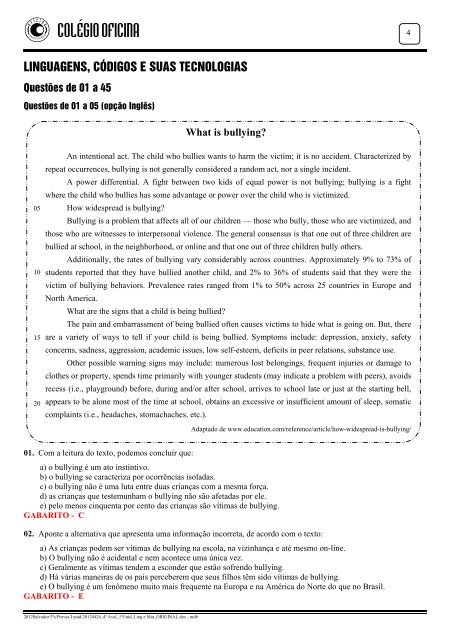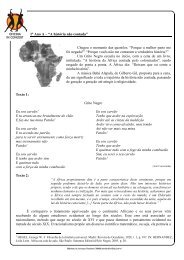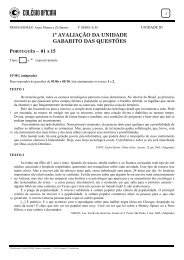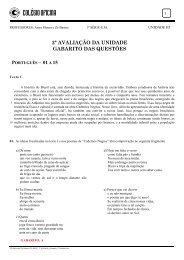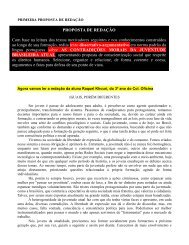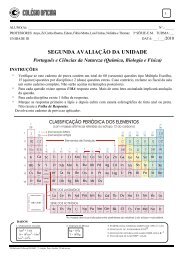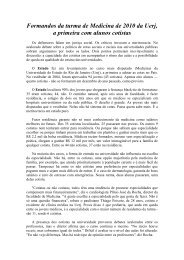linguagens, códigos e suas tecnologias - Colégio Oficina
linguagens, códigos e suas tecnologias - Colégio Oficina
linguagens, códigos e suas tecnologias - Colégio Oficina
Create successful ePaper yourself
Turn your PDF publications into a flip-book with our unique Google optimized e-Paper software.
COLÉGIO OFICINA<br />
LINGUAGENS, CÓDIGOS E SUAS TECNOLOGIAS<br />
Questões de 01 a 45<br />
Questões de 01 a 05 (opção Inglês)<br />
What is bullying?<br />
An intentional act. The child who bullies wants to harm the victim; it is no accident. Characterized by<br />
repeat occurrences, bullying is not generally considered a random act, nor a single incident.<br />
A power differential. A fight between two kids of equal power is not bullying; bullying is a fight<br />
where the child who bullies has some advantage or power over the child who is victimized.<br />
05 How widespread is bullying?<br />
Bullying is a problem that affects all of our children — those who bully, those who are victimized, and<br />
those who are witnesses to interpersonal violence. The general consensus is that one out of three children are<br />
bullied at school, in the neighborhood, or online and that one out of three children bully others.<br />
Additionally, the rates of bullying vary considerably across countries. Approximately 9% to 73% of<br />
10 students reported that they have bullied another child, and 2% to 36% of students said that they were the<br />
victim of bullying behaviors. Prevalence rates ranged from 1% to 50% across 25 countries in Europe and<br />
North America.<br />
What are the signs that a child is being bullied?<br />
The pain and embarrassment of being bullied often causes victims to hide what is going on. But, there<br />
15 are a variety of ways to tell if your child is being bullied. Symptoms include: depression, anxiety, safety<br />
concerns, sadness, aggression, academic issues, low self-esteem, deficits in peer relations, substance use.<br />
Other possible warning signs may include: numerous lost belongings, frequent injuries or damage to<br />
clothes or property, spends time primarily with younger students (may indicate a problem with peers), avoids<br />
recess (i.e., playground) before, during and/or after school, arrives to school late or just at the starting bell,<br />
20 appears to be alone most of the time at school, obtains an excessive or insufficient amount of sleep, somatic<br />
complaints (i.e., headaches, stomachaches, etc.).<br />
01. Com a leitura do texto, podemos concluir que:<br />
a) o bullying é um ato instintivo.<br />
b) o bullying se caracteriza por ocorrências isoladas.<br />
c) o bullying não é uma luta entre duas crianças com a mesma força.<br />
d) as crianças que testemunham o bullying não são afetadas por ele.<br />
e) pelo menos cinquenta por cento das crianças são vítimas de bullying.<br />
GABARITO - C<br />
Adaptado de www.education.com/reference/article/how-widespread-is-bullying/<br />
02. Aponte a alternativa que apresenta uma informação incorreta, de acordo com o texto:<br />
a) As crianças podem ser vítimas de bullying na escola, na vizinhança e até mesmo on-line.<br />
b) O bullying não é acidental e nem acontece uma única vez.<br />
c) Geralmente as vítimas tendem a esconder que estão sofrendo bullying.<br />
d) Há várias maneiras de os pais perceberem que seus filhos têm sido vítimas de bullying.<br />
e) O bullying é um fenômeno muito mais frequente na Europa e na América do Norte do que no Brasil.<br />
GABARITO - E<br />
2012Salvador/3ªs/Provas/I unid/20120424_4ª Aval_1ªUnid_Ling e Mat_ORIGINAL.doc - mdb<br />
4


